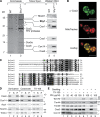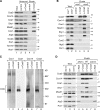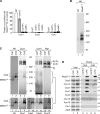Coa3 and Cox14 are essential for negative feedback regulation of COX1 translation in mitochondria
- PMID: 20876281
- PMCID: PMC2953447
- DOI: 10.1083/jcb.201007026
Coa3 and Cox14 are essential for negative feedback regulation of COX1 translation in mitochondria
Abstract
Regulation of eukaryotic cytochrome oxidase assembly occurs at the level of Cox1 translation, its central mitochondria-encoded subunit. Translation of COX1 messenger RNA is coupled to complex assembly in a negative feedback loop: the translational activator Mss51 is thought to be sequestered to assembly intermediates, rendering it incompetent to promote translation. In this study, we identify Coa3 (cytochrome oxidase assembly factor 3; Yjl062w-A), a novel regulator of mitochondrial COX1 translation and cytochrome oxidase assembly. We show that Coa3 and Cox14 form assembly intermediates with newly synthesized Cox1 and are required for Mss51 association with these complexes. Mss51 exists in equilibrium between a latent, translational resting, and a committed, translation-effective, state that are represented as distinct complexes. Coa3 and Cox14 promote formation of the latent state and thus down-regulate COX1 expression. Consequently, lack of Coa3 or Cox14 function traps Mss51 in the committed state and promotes Cox1 synthesis. Our data indicate that Coa1 binding to sequestered Mss51 in complex with Cox14, Coa3, and Cox1 is essential for full inactivation.
Figures







Similar articles
-
Cox25 teams up with Mss51, Ssc1, and Cox14 to regulate mitochondrial cytochrome c oxidase subunit 1 expression and assembly in Saccharomyces cerevisiae.J Biol Chem. 2011 Jan 7;286(1):555-66. doi: 10.1074/jbc.M110.188805. Epub 2010 Nov 10. J Biol Chem. 2011. PMID: 21068384 Free PMC article.
-
Dual functions of Mss51 couple synthesis of Cox1 to assembly of cytochrome c oxidase in Saccharomyces cerevisiae mitochondria.Mol Biol Cell. 2009 Oct;20(20):4371-80. doi: 10.1091/mbc.e09-06-0522. Epub 2009 Aug 26. Mol Biol Cell. 2009. PMID: 19710419 Free PMC article.
-
A Novel Function of Pet54 in Regulation of Cox1 Synthesis in Saccharomyces cerevisiae Mitochondria.J Biol Chem. 2016 Apr 22;291(17):9343-55. doi: 10.1074/jbc.M116.721985. Epub 2016 Feb 29. J Biol Chem. 2016. PMID: 26929411 Free PMC article.
-
Cytochrome c oxidase biogenesis - from translation to early assembly of the core subunit COX1.FEBS Lett. 2023 Jun;597(12):1569-1578. doi: 10.1002/1873-3468.14671. Epub 2023 May 31. FEBS Lett. 2023. PMID: 37247261 Review.
-
Biogenesis of cytochrome oxidase-sophisticated assembly lines in the mitochondrial inner membrane.Gene. 2005 Jul 18;354:43-52. doi: 10.1016/j.gene.2005.03.017. Gene. 2005. PMID: 15905047 Review.
Cited by
-
The Cox1 C-terminal domain is a central regulator of cytochrome c oxidase biogenesis in yeast mitochondria.J Biol Chem. 2017 Jun 30;292(26):10912-10925. doi: 10.1074/jbc.M116.773077. Epub 2017 May 10. J Biol Chem. 2017. PMID: 28490636 Free PMC article.
-
Mechanisms and regulation of protein synthesis in mitochondria.Nat Rev Mol Cell Biol. 2021 May;22(5):307-325. doi: 10.1038/s41580-021-00332-2. Epub 2021 Feb 16. Nat Rev Mol Cell Biol. 2021. PMID: 33594280 Review.
-
Allotopic expression of COX6 elucidates Atco-driven co-assembly of cytochrome oxidase and ATP synthase.Life Sci Alliance. 2023 Aug 21;6(11):e202301965. doi: 10.26508/lsa.202301965. Print 2023 Nov. Life Sci Alliance. 2023. PMID: 37604582 Free PMC article.
-
Mam33 promotes cytochrome c oxidase subunit I translation in Saccharomyces cerevisiae mitochondria.Mol Biol Cell. 2015 Aug 15;26(16):2885-94. doi: 10.1091/mbc.E15-04-0222. Epub 2015 Jun 24. Mol Biol Cell. 2015. PMID: 26108620 Free PMC article.
-
Redox and reactive oxygen species regulation of mitochondrial cytochrome C oxidase biogenesis.Antioxid Redox Signal. 2013 Dec 1;19(16):1940-52. doi: 10.1089/ars.2012.4847. Epub 2012 Oct 15. Antioxid Redox Signal. 2013. PMID: 22937827 Free PMC article. Review.
References
Publication types
MeSH terms
Substances
LinkOut - more resources
Full Text Sources
Molecular Biology Databases

